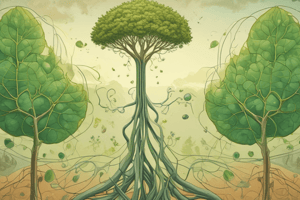Podcast
Questions and Answers
Chlorophyll a is the only pigment that can transfer the energy of light to the carbon fixation reactions of photosynthesis.
Chlorophyll a is the only pigment that can transfer the energy of light to the carbon fixation reactions of photosynthesis.
True (A)
Electrons at higher energy levels in chlorophyll are stable and do not fall back to their ground state.
Electrons at higher energy levels in chlorophyll are stable and do not fall back to their ground state.
False (B)
Chlorophyll b absorbs red light the best.
Chlorophyll b absorbs red light the best.
False (B)
Carotenoids and xanthophylls are examples of accessory pigments that help in light absorption for photosynthesis.
Carotenoids and xanthophylls are examples of accessory pigments that help in light absorption for photosynthesis.
The green wavelengths of light are absorbed by chlorophyll and contribute to photosynthesis.
The green wavelengths of light are absorbed by chlorophyll and contribute to photosynthesis.
Cyanobacteria are examples of prokaryotic autotrophs that can cause algal blooms.
Cyanobacteria are examples of prokaryotic autotrophs that can cause algal blooms.
Eukaryotic autotrophs do not contain chloroplasts.
Eukaryotic autotrophs do not contain chloroplasts.
Photosynthesis in higher order plants primarily occurs in the roots.
Photosynthesis in higher order plants primarily occurs in the roots.
Stomata are responsible for controlling gas exchange in plants.
Stomata are responsible for controlling gas exchange in plants.
Light energy is directly proportional to the wavelength of electromagnetic radiation.
Light energy is directly proportional to the wavelength of electromagnetic radiation.
Plant pigments reflect all wavelengths of light equally.
Plant pigments reflect all wavelengths of light equally.
The thylakoid membrane is a key component of chloroplasts and is involved in photosynthesis.
The thylakoid membrane is a key component of chloroplasts and is involved in photosynthesis.
Osmosis in guard cells leads to their swelling and the opening of stomata.
Osmosis in guard cells leads to their swelling and the opening of stomata.
Study Notes
Prokaryotic Autotrophs
- Cyanobacteria, also known as blue-green algae, is an example of a prokaryotic autotroph
- Thrive on nitrogen and phosphate, which can lead to algal blooms that discolour water and be toxic to other species.
- First living thing to produce oxygen, existing about 3.5 to 4 billion years ago.
Eukaryotic Autotrophs
- Algae, plants, and photosynthetic protists are examples of eukaryotic autotrophs
- These organisms possess organelles called chloroplasts that contain chlorophyll.
Photosynthesis in Plants
- Occurs primarily in the spongy and palisade mesophyll of leaves
- Chloroplasts contain thylakoids where chlorophyll molecules are located.
Transpiration
- The loss of water from leaves
- Pulls water up the plant from roots due to water cohesion
- Assists photosynthesis by moving substances (water, minerals, etc.) to leaves
- Has an evaporative cooling effect, preventing inhibition or denaturation of photosynthetic enzymes.
Control of Stomata
- Stomata are openings on the surface of leaves that allow for the movement of gases (CO2 and water vapour)
- Their size is controlled by guard cells.
Stomata Control Mechanism
- Light activates specific receptors in guard cell membranes.
- This stimulates proton pumps that move protons out of the cell.
- An electrochemical gradient is created, causing K+ ions to move into the cell.
- Water moves in by osmosis.
Chloroplast Structure
- The chloroplast contains stroma, a protein-rich fluid.
- Thylakoids, stacks of flattened sacs, are attached to grana.
Location of Photosynthesis
- Occurs in the stroma and thylakoid membrane.
- The thylakoid membrane contains:
- Light-gathering pigment molecules (chlorophyll)
- Electron transport chains
- The structure of the thylakoid system increases surface area and photosynthesis efficiency.
Plant Pigments
- Pigments absorb specific wavelengths of light while reflecting others.
- Chlorophyll is easily excited by light and plays a key role in photosynthesis.
Properties of Light
- Light (electromagnetic radiation) is a form of energy that travels in the form of wave packets called photons.
- The amount of energy is inversely proportional to the wavelength (λ): E=1/λ.
- The visible part of the electromagnetic spectrum ranges from 380 nm to 750 nm.
Effect of Light on Atoms
- Light energy directed at atoms can cause electrons to move to higher energy levels.
- Electrons at higher levels are unstable and fall back down to their ground state, releasing energy (in the form of light) as they fall.
Chlorophyll
- Photosynthetic organisms contain the green-coloured pigment chlorophyll.
- Consists of a Porphyrin ring (complex ring with carbon double bonds containing a Mg atom) and a Phytol chain (hydrocarbon that anchors and orients the molecule).
- Chlorophyll a and b differ in the ‘R’ group attached to the head.
Chlorophyll a and b
- Chlorophyll a absorbs red light best.
- Chlorophyll b absorbs violet-blue light best.
- Green wavelengths are not absorbed and are reflected, which is why plants appear green.
Carotenoid Pigments
- Beta-carotene absorbs particular wavelengths and reflects yellows to reds.
- Xanthophylls absorb yellows and reflect oranges.
Chlorophyll and Accessory Pigments
- Chlorophyll a is the only pigment that can transfer light energy to the carbon fixation reactions of photosynthesis.
- Chlorophyll b, carotenoids, xanthophylls, and anthocyanins act as accessory pigments, absorbing photons that chlorophyll a absorbs poorly or not at all.
Absorbance Spectra
- Show the relationship between the amount of light absorbed by a pigment and the wavelength of light.
Action Spectrum
- Shows the rate of oxygen production related to the wavelengths of light absorbed.
Autumn Leaves
- The change in leaf colour during autumn is due to the breakdown of chlorophyll, revealing the colours of other pigments (carotenoids and anthocyanins).
Studying That Suits You
Use AI to generate personalized quizzes and flashcards to suit your learning preferences.
Related Documents
Description
Explore the fascinating world of autotrophs with this quiz on prokaryotic and eukaryotic organisms. Learn about cyanobacteria, algae, and the crucial process of photosynthesis in plants. Understand the roles of chloroplasts, transpiration, and how these organisms contribute to our ecosystem.




